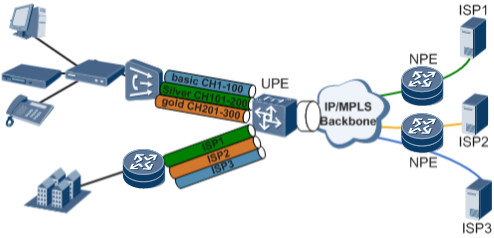Layer 2 Multicast CAC
Background
With the growing popularity of IPTV applications, multicast services are more widely deployed than ever. When multicast services are deployed on a Layer 2 network, a number of problems may arise:
- If users join a large number of multicast groups, sparsely distributed multicast groups will increase performance pressure on network devices.
- If network bandwidth is insufficient, the demand for bandwidth resources will exceed the total bandwidth of the network, overloading aggregation layer devices and degrading user experience.
- If multicast packets are used to attack a network, network devices become busy processing attack packets and cannot respond to normal network requests.
- If static multicast group management policies are used, user requests for access to a variety of different multicast services cannot be met. Service providers expect more refined channel management. For example, they expect to limit the number and bandwidth of multicast groups in channels.
Related Concepts
The following concepts are involved in multicast CAC.
- Call Admission Control (CAC): provides a series of rules for controlling multicast entry learning, including the multicast group quantity and bandwidth limits for each multicast group, as well as for each channel. Layer 2 multicast CAC is used to perform CAC operations for multicast services on Layer 2 networks.
- Channel: consists of a series of multicast groups, each of which can have its own bandwidth attribute. For example, a TV channel consists of two groups, TV-1 and TV-5, with the bandwidth of 4 Mbit/s and 18 Mbit/s, respectively.
Implementation
Layer 2 multicast CAC constrains the generation of multicast forwarding entries. When a preset threshold is reached, no more forwarding entries can be generated. This ensures that devices have adequate processing capabilities and controls link bandwidth.
Layer 2 multicast CAC can restrict the following items:
Restriction on the number and bandwidth of multicast groups
The number of multicast groups allowed can be limited when a device creates Layer 2 multicast forwarding entries. This protects device and network performance by limiting the number of groups available for users to join. After IGMP Report messages are received from downstream user hosts, the device checks CAC statistics to determine whether the threshold for the number of multicast groups has been reached. If the threshold has not been reached, a forwarding entry is generated and CAC statistics are updated to show the increase in groups. If the threshold has been reached, no entry is generated. When IGMP Leave messages are received or entries age, the entries are deleted and CAC statistics are updated.
If the bandwidth of each multicast group is fixed and each group uses approximately the same amount of bandwidth, the total bandwidth for multicast traffic is basically fixed. For example, if there are 20 multicast groups and each multicast group has 4 kbit/s of bandwidth, the total bandwidth for multicast traffic is 80 kbit/s. If there are 20 multicast groups and the bandwidth values of the multicast groups are different, some being 4 kbit/s and the others being 18 kbit/s, the total bandwidth for multicast traffic cannot be determined. In a case like this, setting a limit on the number of multicast groups is not adequate to control bandwidth. Bandwidth usage must be limited.
Restriction on the number and bandwidth of multicast groups in a channel
If a network offers channels for different content providers, the number of multicast groups and the amount of bandwidth must be limited based on channels.
Before a Layer 2 multicast entry is generated, the multicast group address must be checked to determine which channel's address range to which this address belongs. Whether CAC is configured for the address range needs to be checked also. If CAC is configured for the address range and the number or bandwidth of member multicast groups exceeds the upper threshold, the Layer 2 entry will not be generated. The Layer 2 entry will be generated only if the number or bandwidth of member multicast groups is below the upper threshold.
Deployment Scenarios
Layer 2 multicast CAC applies to VPLS networks.
Benefits
The Layer 2 multicast CAC feature provides the following benefits:
- For providers:
- Provides channel-based restrictions, allowing service providers to implement refined multicast service management.
- Improves multicast service security.
- For users:
- Prevents bandwidth resources required from exceeding the total bandwidth of the aggregation network and ensures service quality for users.
- Improves multicast service security.
